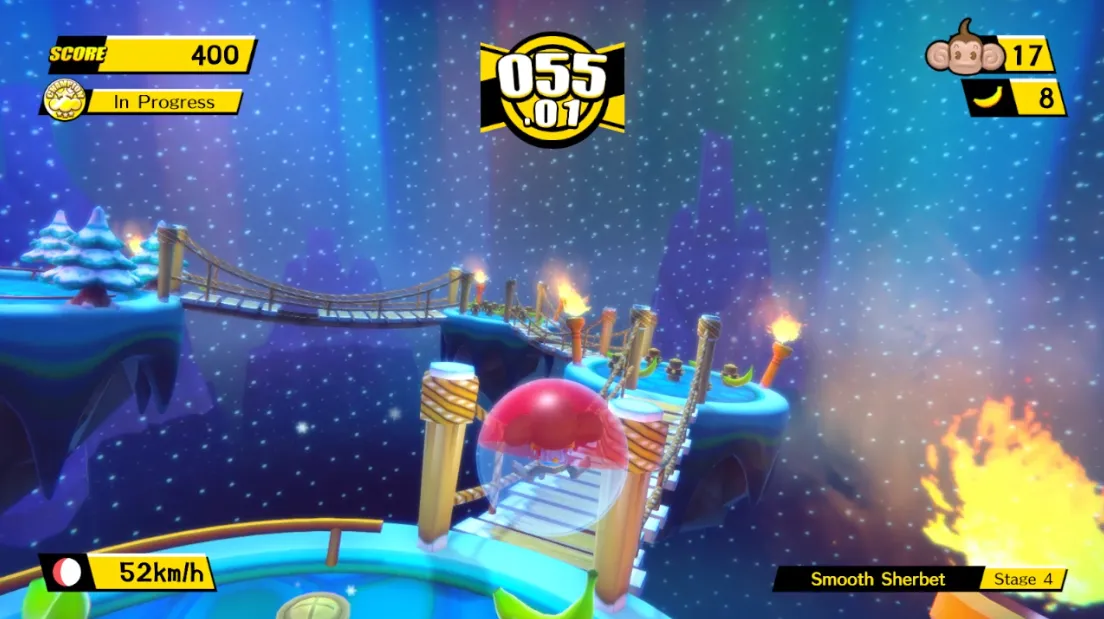

You know, while it could very much be my mood when I approached the game, I definitely remember trying it with open arms and mind - but the first thoughts that were starting to come in after enough time was:
...Isn't this just Marble Blast?
See, while Super Monkey Ball and Marble Blast could be related in that both are marble rolling games over platforms, what differentiated classic Super Monkey Ball from Marble Blast is what each other emphasized for gameplay.
Classic Super Monkey Ball, as it originated as a joystick-only arcade game, is about precision with the analog stick to steer over these stages that often make good use of the physics to offer a challenge or even some cool skips if you feel like it.
Marble Blast instead is about platforming with a ball that, while does have some levels about crossing tightropes, is less about precision with the physics of the analog stick but more so about how you interact with the levels through the ability to jump and the power ups. Again, its more like platforming with a ball than carefully playing a marble maze.
So...Super Monkey Ball Banana Blitz HD is basically a weird middle spot between both ideas due to the focus on jumping that the original game had, which means that you get some stages that vaguely or actively try to have those sections for precise controls...but on top of the controls not being as precise as the original Gamecube games to feel as good, the jump button either lets you trivialize the simpler levels or feels mandatory only as a crutch for some tougher levels where doing it the normal way or keeping your balance without jumps is far more painful than you'd think.
Oh, and of course, the many levels that are designed for jumping...so in those, the most balancing you do is whenever you bounce off landing after a jump and try to stabilize to move wherever you go.
I guess that this is a bit of a more aggressive/critical introduction than what I usually deliver, but I think that the gripes go beyond the sole comparison between old and new Monkey Ball, which is something I'll show through explaining my journey through it.
The caveat of porting a motion-control oriented game to a joystick
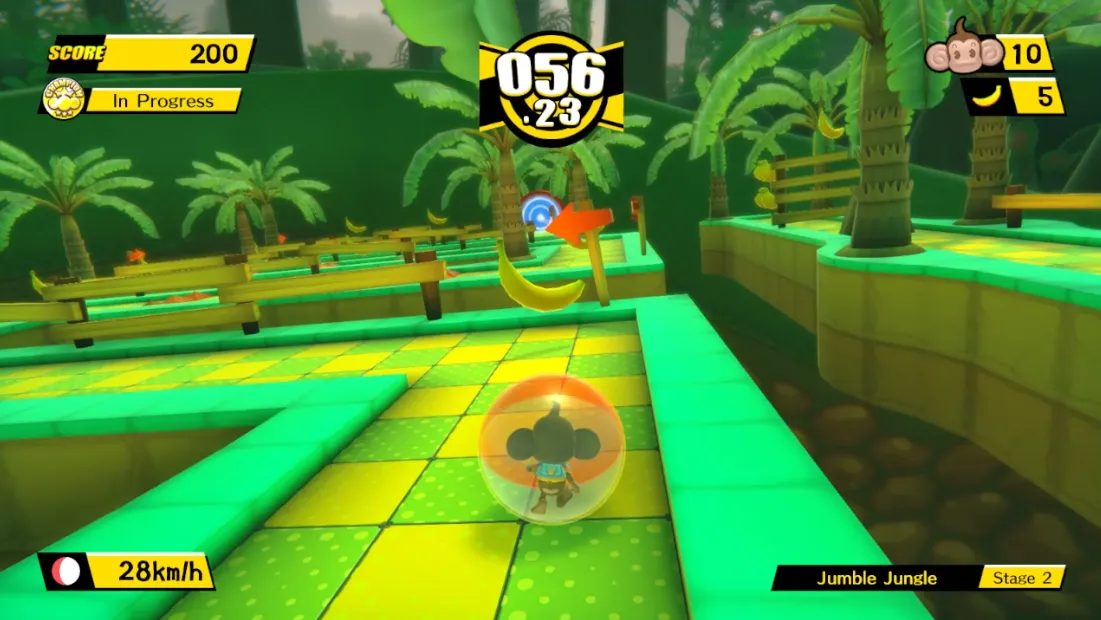
If there's something that sticks out in the first worlds of this game, is that they are easy to the point of being somewhat mindless or just easily exploitable with jumps - most notably having guard rails very often unlike the classic games taking off those training wheels after the first few levels.
That's because, in case you aren't aware yet, the original game was made for the Wii...and was made to be played exclusively with motion controls by holding the Wii Remove vertically like a TV remote, as the game doesn't let you play with normal controls [Wii Remote's D-Pad, Nunchuck, Gamecube Controller] or even at the very least hold the Wii Remote horizontally. The only button you get to use in that game is the A button to jump.
So it is quite evident that most early levels compromise with a bunch of guard rails to compensate for those motion controls...which remain there even in this now motion-less version of the game [which apparently doesn't even support Gyro controls as an option].
You still have the jump in case you want to try for easy skips in levels that allow it, but at that point are playing more Marble Blast than Monkey Ball if you can either trivialize levels in difficulty [which aren't all that complex early on] as you can jump repeatedly to bounce around, or even trivialize their level design altogether [since some levels have pathways with walls...but because you can jump, you can just ignore those].
The following is a screenshot from a lategame level, where while there's a thin path on the left that lets you get to the lower area while allowing you to pick up some bananas on the way...

...It also has the lower area being reachable with a simple jump from the beginning, meaning that you can choose to not interact with most of the level design at all.
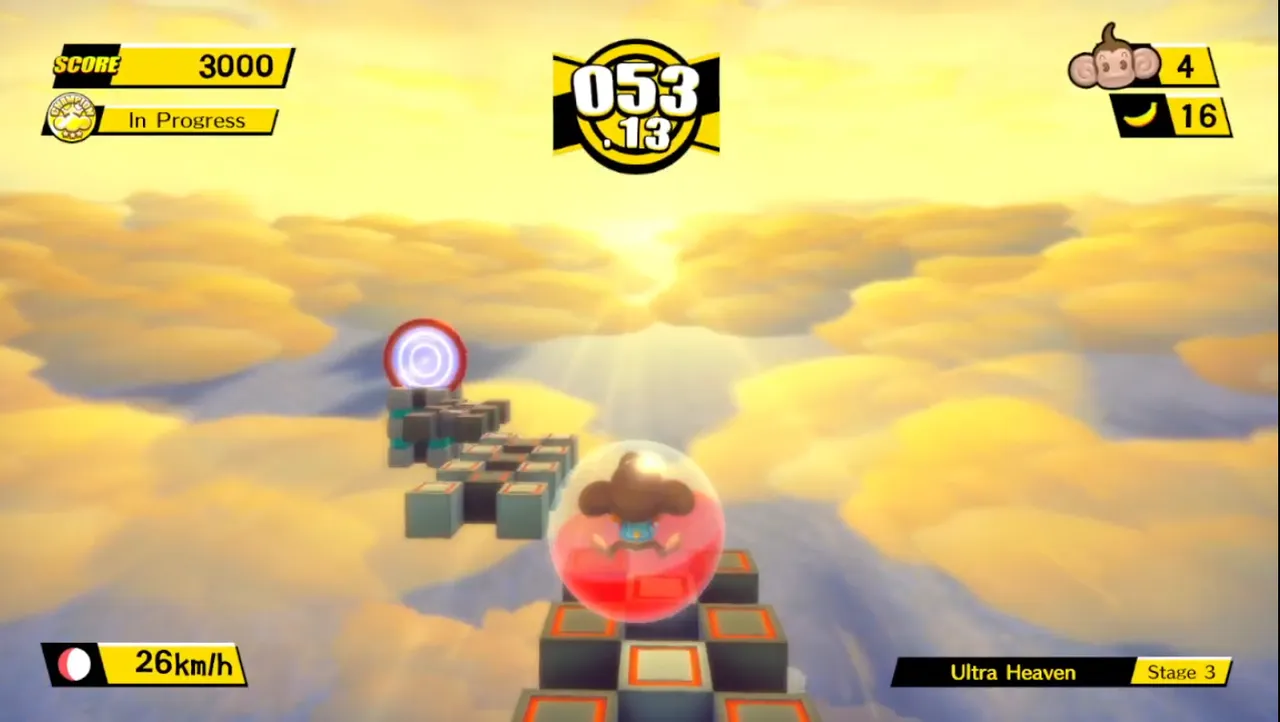
There are many cases as this, and its a weird feeling on tethering between [easy or very annoying to beat normally] and [easy or very annoying to cheese] - and while some stages are harder to cheese than others, the option being there in the case both the cheese and the normal strat are difficult often incentivized me to just go for the cheese instead, because for what else hey gave me this jump button, right?
I guess that's the catch with this game, more so in the context of other Monkey Ball games: The jump button makes levels either easily bypassable by using it or is necessary for some levels made for it in mind, which is why I made the comparison to Marble Blast and how this can feel odd as a Monkey Ball game when you don't get the same need to commit to treading a level through the ground [unless you need extra lives from bananas on the way] or even try to do jumps through running over bumps when you are given a commitment-free jump button.
But on the note of lategame levels, there's some levels that stick out later in how they treat you despite being carried over almost intact from the Wii versoin, but there's also a few that get a big bump in difficulty due to a specific change they made which I'll mention later. But on the note of changes...
Good looking for the most part, but not as good sounding as before
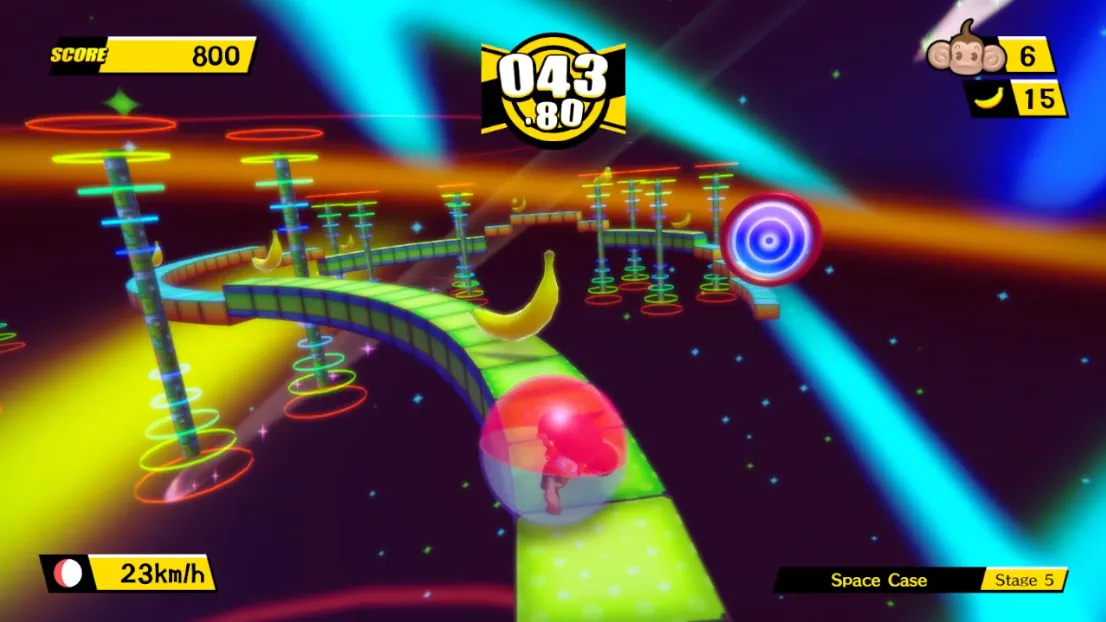
The presentation is mostly clean on the visual front [whether you prefer the more minimalistic and clean HUD of this version or the original style from the Wii is up to you], but something that is easy to notice whenever you played the original version or not is the way music selection was handled.
A lot of the songs from the original Banana Blitz were replaced [apparently due to legal reasons, somehow] with new songs...except that most songs used as replacements aren't even new, but recycled from other Super Monkey Ball games.
This is way more evident if you've played the first two games, since songs from SMB1, SMB2 and even SMB3D are spread throughout the game - which even without that context can still sound fairly unfitting, like the SMB1 Credits playing over the first boss, SMB3D's Sweet Fountain being used for the World 3 boss [which isn't exactly threatening but THAT isn't what you'd expect], SMB1's Space theme being used for the Volcano world, and so on, so forth.
There are some hints of decent choices and proper new songs here and there, like SMB1's Storm theme, while being used for the final boss that is a pirate monkey in space, at least makes a bit more of sense than the rest, Sinking Swamps getting a new theme that sounds good, and the funniest case of all that makes World 3's replaced boss theme stick out even more, World 3/Smooth Sherbet's theme being completely unchanged - meaning that you'll actually get an instantly recognizable tune straight from Hideki Naganuma, which is also the only song in the entire game that wasn't replaced from the original.
But otherwise, the songs are a mixed bag, perhaps not so much as quality but more so as how they are slapped over from other titles with different contexts, likely sticking out a weird bit in some stages for those who don't know, while being VERY obvious for those who do - and most notably, a lot of good tunes tailor made for the Wii version being removed in the first place if you've heard them before.
This is also a personal nitpick of mine, but when I was going through the game, I ended up muting the voices after the first world, because every time you jump, your monkey of choice would do a noise...and since this is a game where you're meant to jump a lot sooner or later, you can imagine how that became kind of grating to me.
Although unfortunately, my brief testing of the original Banana Blitz on the Wii made me discover that it was like that in the original as well, so its an issue that was brought over from being faithful.
And speaking of issues brought over from the original game...
What do you mean you want me to do that now?
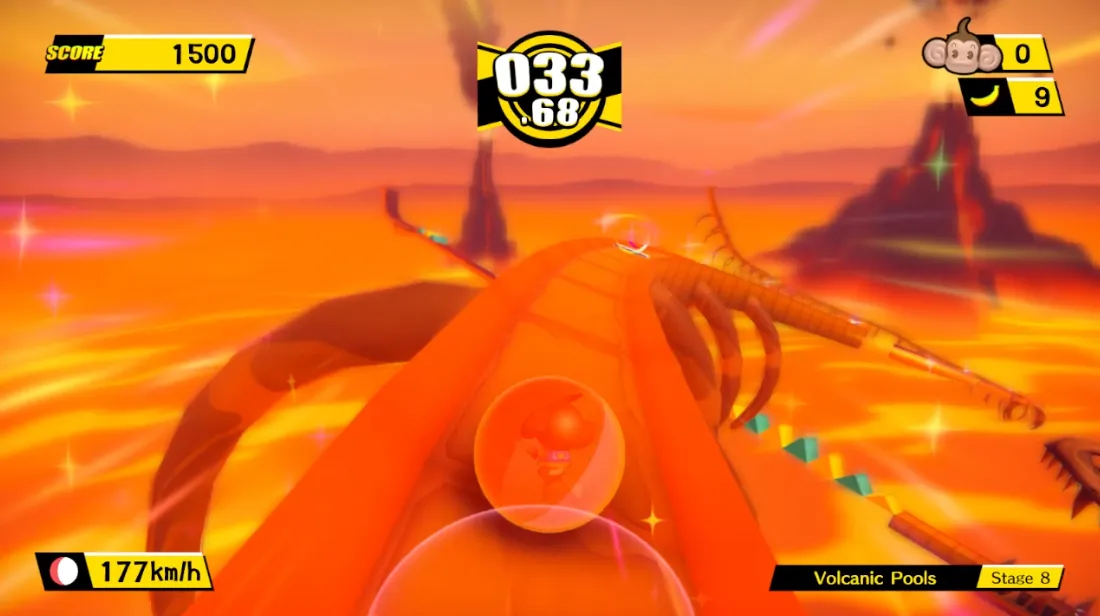
To get the simplest thing out of the way, while the first Monkey Ball games didn't have camera controls, they definitely didn't feel as finicky to deal with camera-wise as Banana Blitz HD does, more so when BBHD's controls are definitely don't allow the same careful precision the GC games did, which you could say is already an issue considering that's old Monkey Ball's appeal. Banana Blitz HD doesn't have camera controls either [this is a thing Banana Mania and Rumble fixed], so you WILL be fighting with the controls to also fight with the camera at times if a stage requires it.
Some of these stages being as much of a nuisance as they were does make me think about how this game was originally designed to be with motion controls only. As in, they were like this in the original version of all things...most of them.
This does come up with the bosses being weird to deal with at times, them being somewhat easier to deal with in a conceptual level when you figure them out, but either being a bit dumb to figure out on your first attempts or having a thing that makes them more of a nuisance than they should be, like the missiles in World 4's Boss. And yes, there are bosses in this game - again, nothing too out of the ordinary but still enough to break the usual pace you'd expect of going through stages.
Stages wise, is mainly with a few stages of choice from World 7 and 8, having some finicky thin paths to go through, having some stages that switch between needing you to rely on boosters and even doing so in a way that you can't beat the stage if you don't get enough speed - or instead having booster panels specifically to inconvenience you if you don't jump over them.
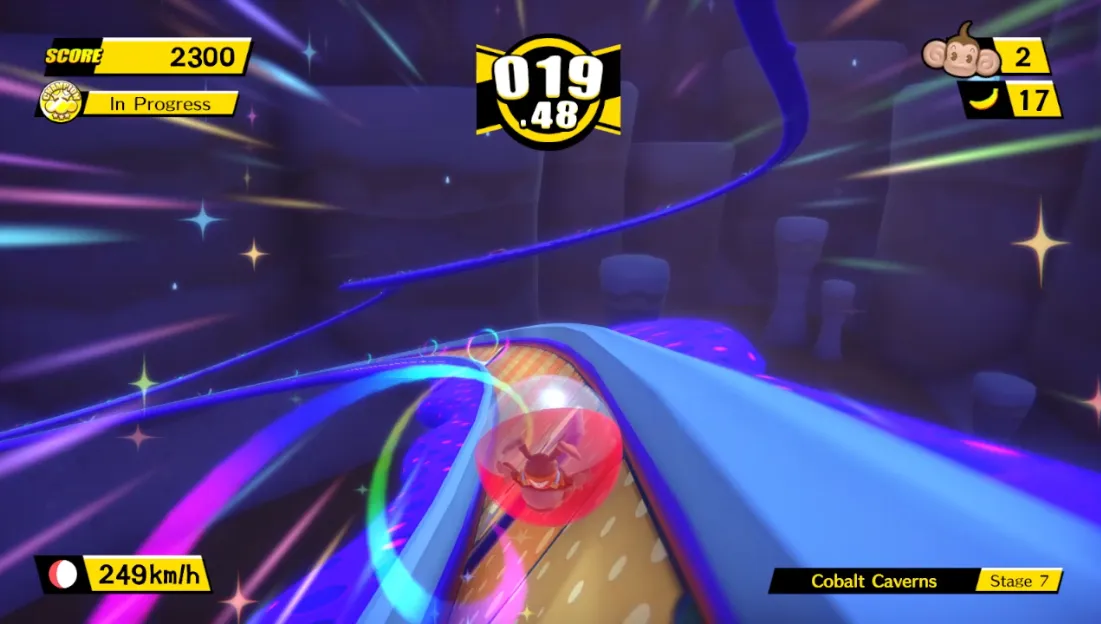
and the elephant in the room that is the topic of World 9 and 10, which originally were locked away as rewards for beating every other world without using continues.
Some levels in World 9 either felt like I needed to crutch with jumps to stabilize myself on the way down of a slanted area or to finish climbing up a steep slope, and certainly had me fighting for a bit with the camera at moments - whether to line myself up for a thin path or just to see where I'm landing after a mandatory jump. Stage 6 of it was rough to deal with at first as I had to figure out without being able to see it well on how to go down the ramp, not fall off and then go up the slim slanted path upwards into the goal.
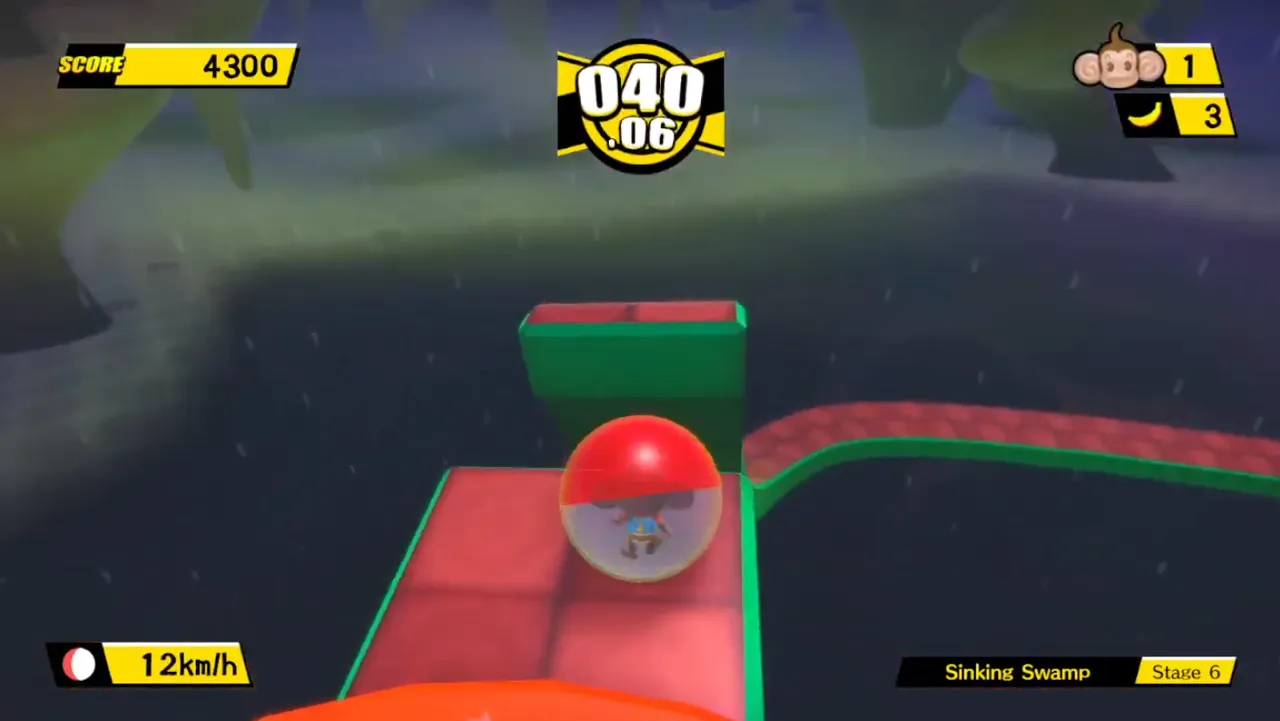
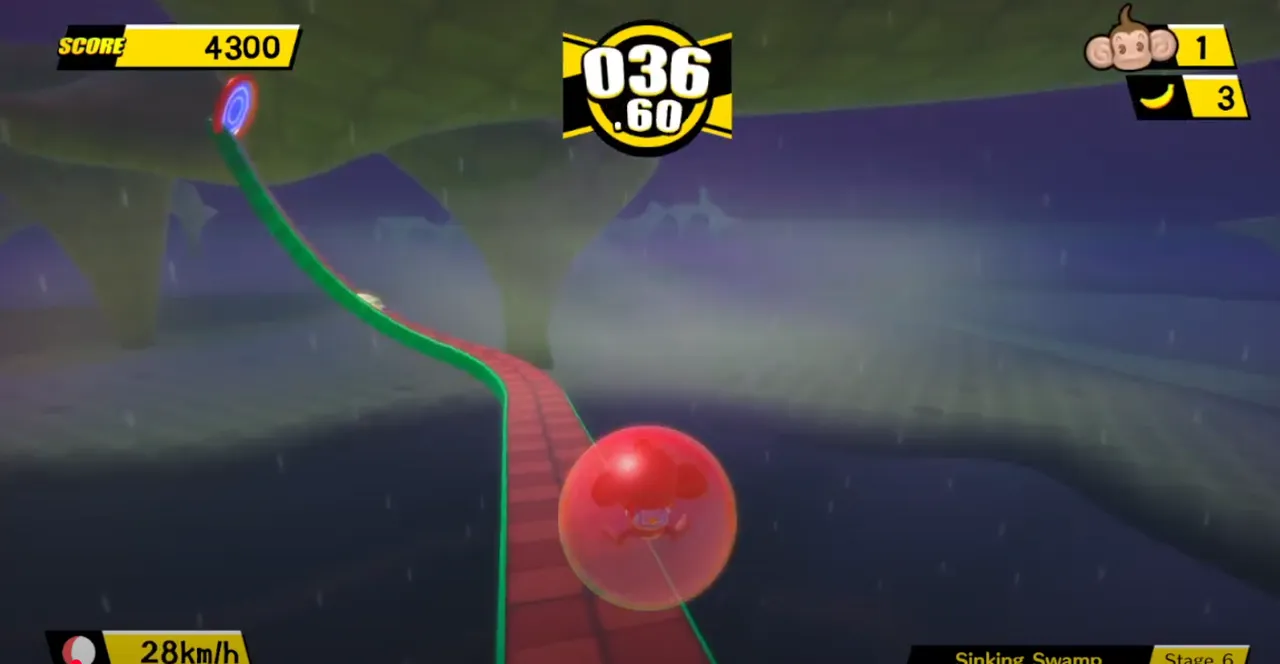
But where it gets real gimmicky is at World 10, where a few stages have some hints of classic Monkey Ball premise in having to keep your balance [like 10-4 where you have to steer over some rolling cylinders], but others are focused on a gimmick, whether a moving part [10-6, 10-7] or more messing with you through sneaker panels [10-9].
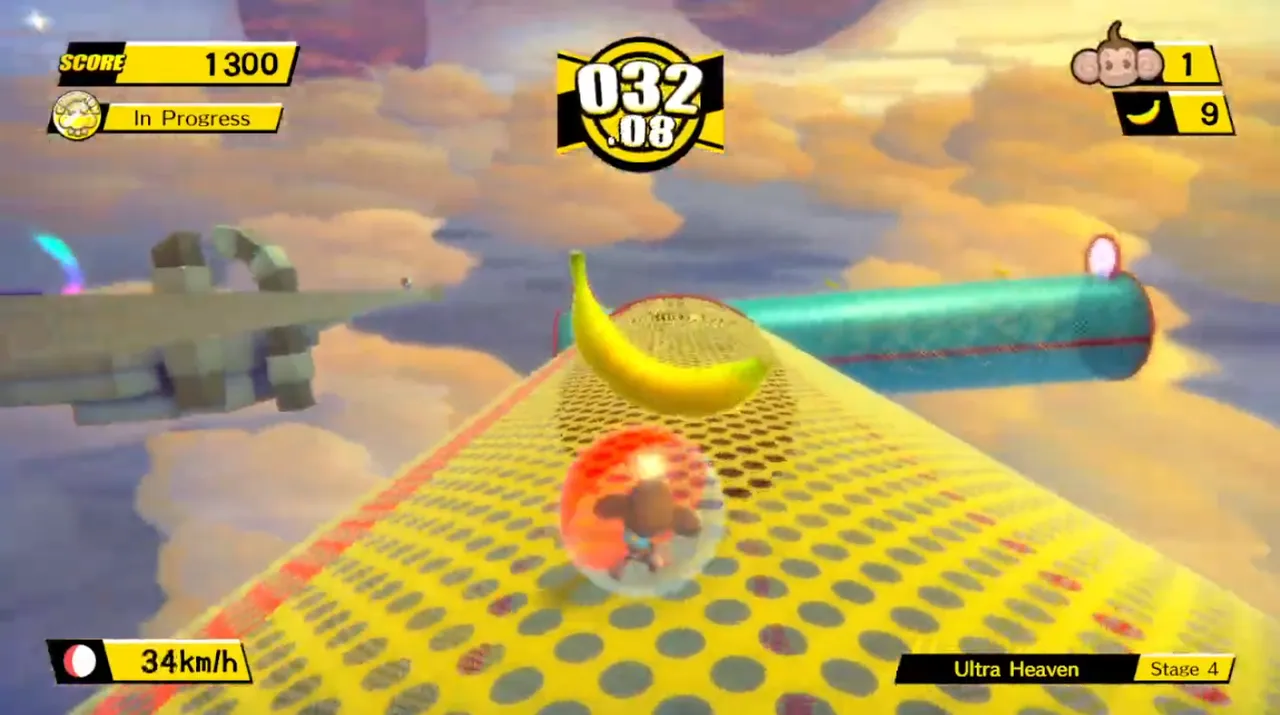
With 10-7, I was dead set on cheesing it out of spite, as a platform could let me jump from high up into the moving platforms from below, but I also had to figure out the right moment where to jump into the goal - too early and I would likely miss the goal but too late and I'd get thrown off course by the platforms tilting downwards.
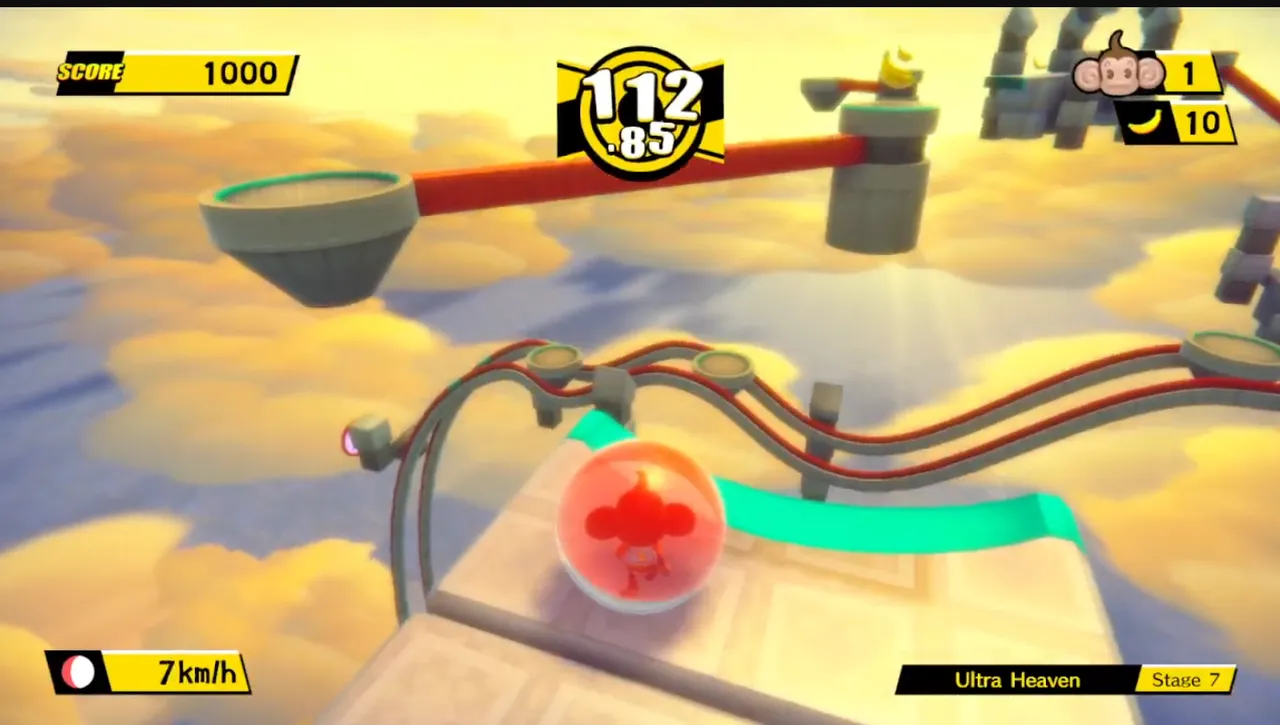
But you know that the real elephant in the room is THAT one stage.
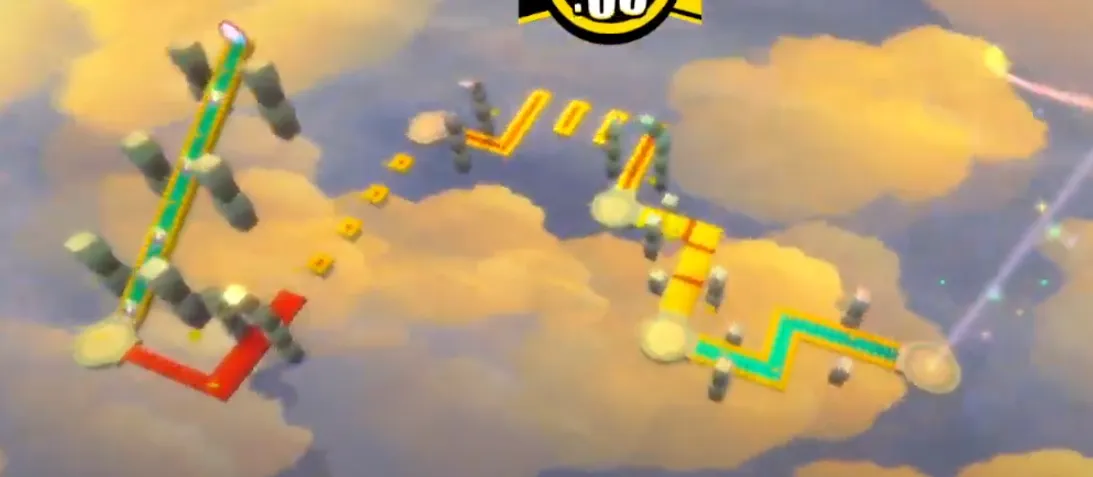
Ultra Heaven 5, and the need of forcing you through what is essentially a scuffed Marble Blast stage due to how you have to be jumping repeatedly at the right time to go across the platforms - except that these have small pyramids on the floor, making for a fair chance that landing in one of those on a bad angle actually sends you off course.


That cursed stage alone took me 30 minutes to beat - and that was with the joystick, let alone entertaining that this was actually just like this in the original Wii version where you play with motion controls through and through.
Although I was told later that GonGon, which is heavier and usually not as good as the rest of the cast, is more convenient as you reduce the chances of getting bounced off course. But I wanted to stick through AiAi on my first playthrough of the whole thing just to stay balanced [and wasn't aware that this awaited me at the end].
You want to know what's funny though? Not ALL of the difficulty in some stages are from the original, but rather added to this version since you don't have motion controls anymore.
You wanted no more rails? Here you go, big shot
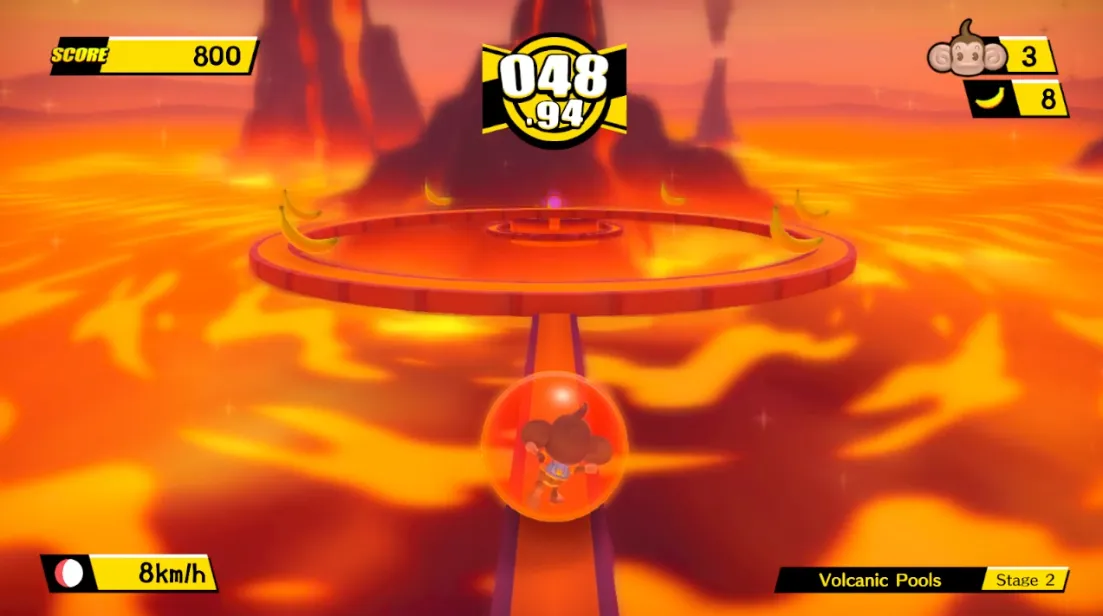
That...looks rough, doesn't it?
Well, if you want to look how the stage above looked like, below is a screenshot of that world in the original Wii version plus a video of the whole world being played in it.
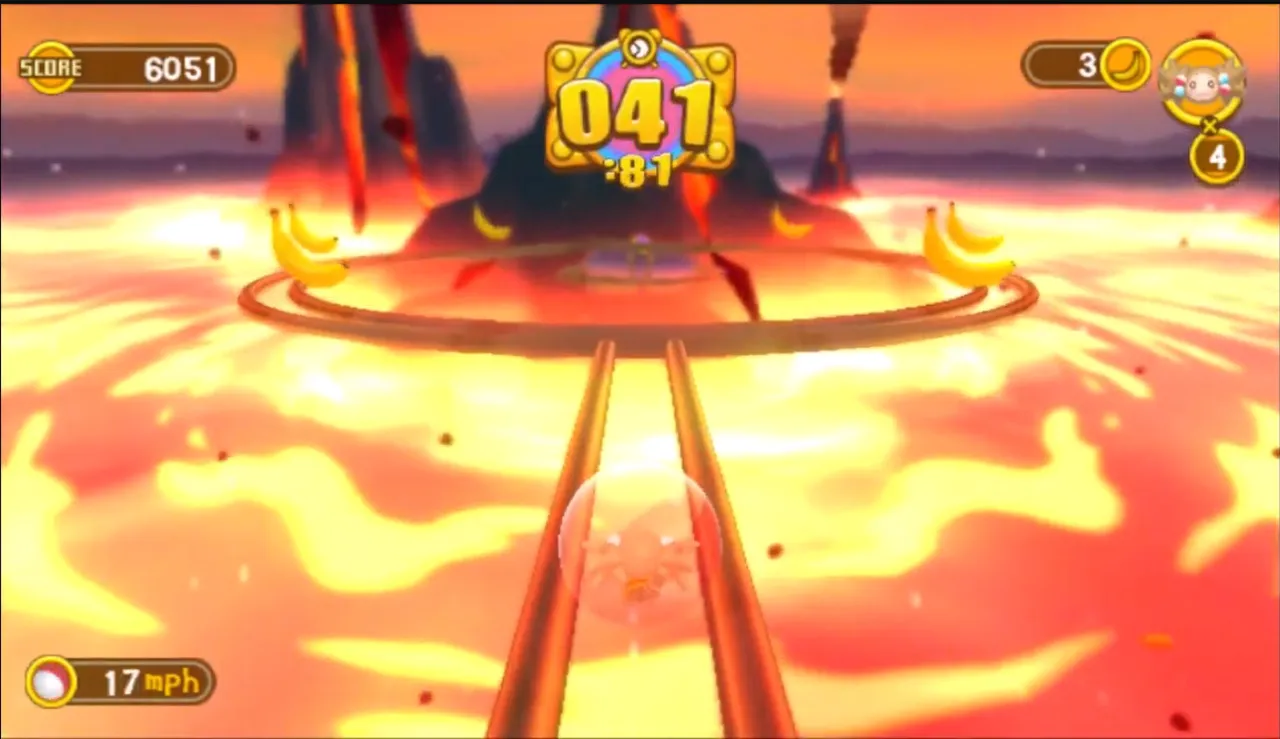
Yeah, I think you may notice the catch here.
All stages that used these rails in the Wii version were replaced with tightrope platforms in the HD version.
In a way, it feels like an attempt at bringing back more of that old Monkey Ball style that you'd see in some old levels...but you have to remember that, once again, the controls in this game aren't as precise as those old games.
This basically makes these stages that relied on rails into patience drainers that you have to somehow carefully maneuver with the twitchy movement you get in here, and some stages definitely feel like they are messing with you with the rail-less versions, such as the stage above having a few banana bunches away from the main path, which you could realistically risk jumping from the rails into the platforms and back, knowing you shouldn't fall off unless you don't get to land on the center of the rail.
...So in the HD version, you can instead easily bounce off the thin roads when landing if you were to try and jump back to them, let alone jumping from them. Which made me have no desire to actually try to go for those banana bunches and more so feel taunted - as well as how this specific stage doesn't have the tightropes connected, meaning you HAVE to jump through those tiny gaps in it with each time risking a bounce into falling out.

Another well known case of these stages going from simple to quite the tough one would be this stage from Cobalt Caverns. Again, these tightropes were rails before, but now you have to ride through these carefully despite your controls - although if you can get to each of these corners then you can hug those walls to go to the next part - or just try to jump into the platform ahead in a pinch, and the ending of the stage is this straight tightrope where I feel like I survived because I thought on the genius idea of...not touching the stick at all when going down there to avoid nudging myself to the sides and falling off.
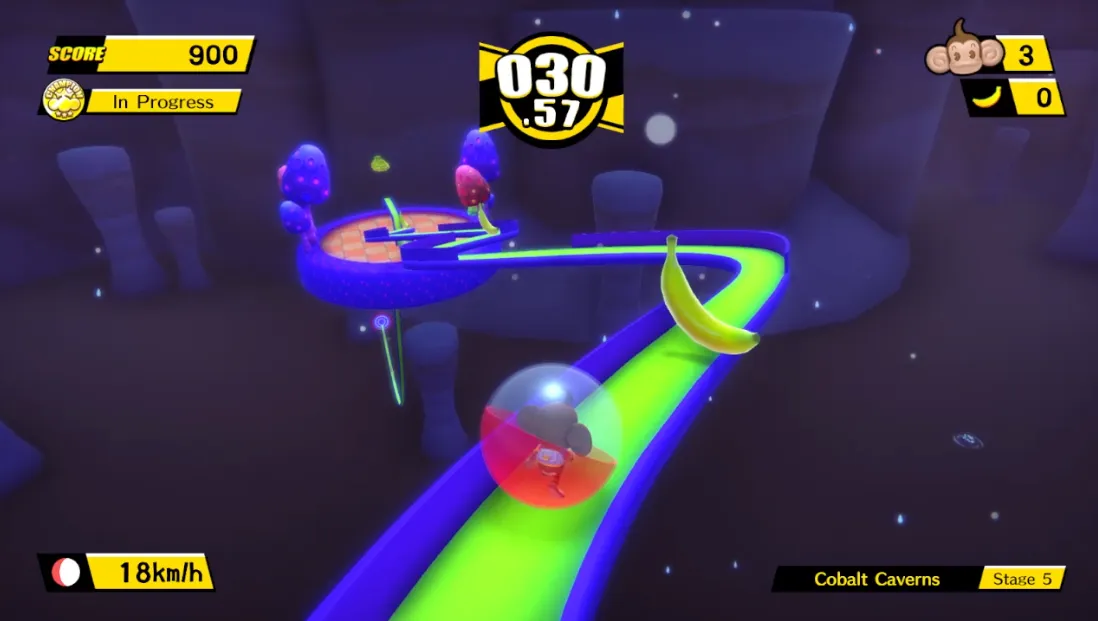
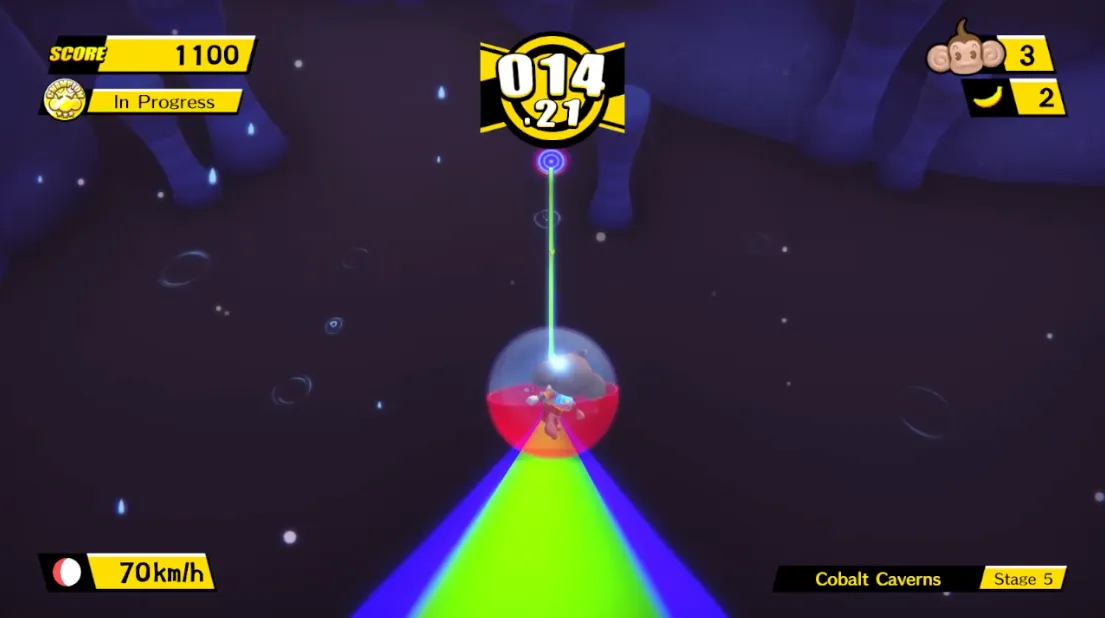
In a way, I feel like I should commend the effort to add extra challenge to those levels with rails in the version with analog controls, but I can see how these have been divisive in a way to the point that people ask why they even made the change [which again, is obviously to add more challenge - but the way a few of the stages are handled definitely feel like sudden overcorrections], and also how the execution suffers because of how Banana Blitz HD is a bit finicky in its controls, making those more of a nuisance than you'd think.
And at the end of the day, most they do is to add an extra sprinkle of difficulty bumps in worlds where most of the other stages end up being more on the inoffensive side, which is what I could describe for this game: Many simple or easy to cheese stages around, but those few stages that show up and enforce a particular gimmick, playstyle or approach that you wouldn't figure out blind stick out the most - ESPECIALLY the last two worlds, which again, feel sort of questionable to have come straight from a game designed for the Wii Remote of all things.
Conclusion
I'm unsure about why I felt more bothered about this one than I expected I would be, knowing that I tried it out for curiosity sake as the remake adding proper controls to this one mixed title of the franchise, but perhaps it was to be that, for the 3 hours it took me to beat all of the worlds in one session, the switching between basic platforming stages and trial-and-error fueled stages, with rare sprinkles of fair challenge or at least a skip that lets you cut some time on those, and that on top of the bosses sometimes draining my lives because of the jank had me more bothered than I wanted to be.
I think that ironically, that may have been because the game has these Champion medals you get informed about straight up and are granted whenever you beat a world without continues - and if starting to lose out on those due to some of those levels in the later worlds being bothersome wasn't enough, don't forget that you'll likely die to the bosses if you aren't ready to slowly play by their rules each time.
There IS a way to work around continues, which is by getting an extra life for each 20 bananas you get, so you can technically keep replaying a specific level with enough bananas to keep grinding for lives, but at that point you're just spending time to make a safety net for a medal - and that's assuming there isn't enough levels that can drain all of those [which to be honest isn't likely going to be happen most of the time if you can get a grip on the controls, except for Ultra Heaven Stage 5 because you WILL be at mercy of every jump in there potentially killing you on a whim].
It sure does feel weird that, while I've often somewhat embraced games with steep challenges at specific times, on top of being aware that the old Super Monkey Ball games also have their fair share of super tough stuff [and either flat out annoying gimmicks, like Arthropod and Switch Inferno, or stages that require you to take some trial-and-error to figure out how to actually use the terrain to beat them like Polar and the SEGA logo], but...
Super Monkey Ball 1 kind of lets you in what each difficulty option will provide on top of being fairly balanced in that regard - as Beginner is fairly easy, Advanced can be done as well if you have experience [I've done it deathless once, but I have to do it again since Polar/A30 is always tough to deal with unless you memorize the fast strat], and Expert is no doubt a level set made for those who are willing to master the art of the monkey ball - let alone the extra levels if you go through all of it with no continues used.
And while Super Monkey Ball 2 offers that same selection through Challenge mode while still containing a few of those gimmick stages that can make runs inconvenient for newcomers, SMB2 also has a Story mode that's divided with 10 levels each, offering not only a more even spread of levels with similar difficulty as you progress, but also knows that its meant to be casual in a way by not having any lives - only making it a matter of time and skill to beat everything without the pressure of doing a challenge mode run in one go and counting your lives.
So while I do have to give credit to Banana Blitz for trying to streamline things by merging the World structure with the lives plus an incentive to keep an eye for them, it certainly feels weird in that, you can have a lot of lives stocked if you keep playing on a single session from the start [or grind for them] to have the Champion medal easier, but you can basically go from thinking the lives are pointless to getting them drained by one of those later stages or bosses and losing the perfect/champion medal.
And if you try to do each world fresh with three lives [or quit and return to play later], then you'll certainly be for a rude awakening. I'm not someone who usually scoffs at extra challenges [as long as they are reasonable depending of the game], but some of those levels stopping me from getting the Champion medal while I was pretty sure restarting the world wouldn't be worth it, did quite bother me for being a first blind playthrough when I was fooled into expecting the game wouldn't play dirty tricks.
Note that the whole strat of farming for lives is something added to the HD version, as the Wii version always starts you with 3 lives when you start a new world - so perfecting Ultra Heaven in the Wii version is just you, three lives, and the urges to not break the Wii Remote from that fifth stage [not to mention everything else under the pressure of knowing that's there].
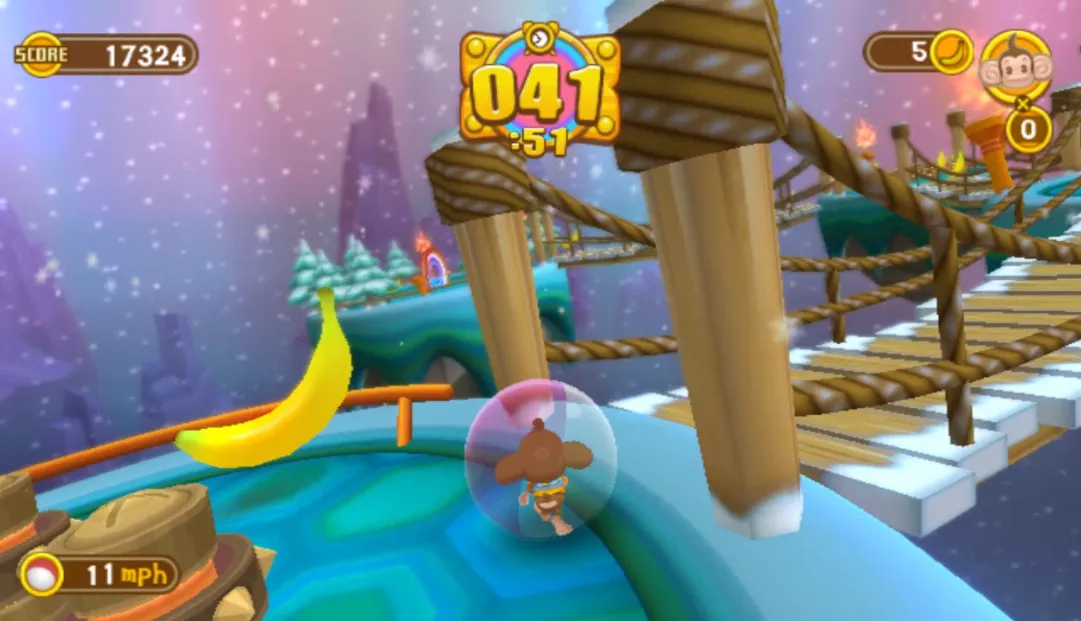
I may go through all of the Wii version one day - the HUD feels more fitting and the songs are intact, but if you emulate it with a joystick, the controls feels like a bit tackier version of what you already get in Banana Blitz HD, on top of the level design being mostly unchanged besides those rail stages [so its either easy peasy or ultra hell]...so at the moment I'm not exactly in a rush to replay that game when my first playthrough of this proper controller enabled remake left me sour.
Got to emphasize how rare it is for me to feel bummed out with the result of playing through a whole game like this and talk this much about it - because again, I didn't intend to try it out with the mindset of bashing it like you'd expect from someone that grew up with the first games [I've even played Super Monkey Ball 3D many years ago as a kid - and I remember enjoying it, but from what I've seen recently, it is NOT a game worth revisiting due to ALL levels being dumbed down], but I guess that on top of the controls being a bit shakier than I expected to deal with tightropes, the emphasis in jumping really had my brain thinking whether I should just be replaying Marble Blast Gold or Ultra at that point, or switch to another Monkey Ball game.
It is just funny to think about when put that way: Overshadowed by the precision of the classic games on the ground, and overshadowed by the more properly platform oriented level design of Marble Blast and Marble It Up in regards to being a jump based marble game.
Banana Blitz definitely got it tough to excel from either side - even if I did like the stage visual design in some worlds, the original Wii soundtrack is full of good stuff, and at the end of the day it is interesting that SEGA revived this game in the same way Capcom revived Capcom Fighting Evolution for Capcom Fighting Collection 2. The last games you'd expect to be brought back, but they were...so I guess they are preserved to be played in modern platforms, somehow.
Although BBHD's release back in the day was kind of controversial in the sense that someone at SEGA had sent the message that BBHD needed to perform if people wanted a remake of the first games or new games altogether, so it certainly must have been sour for old fans to be told they need to buy the remake of the one game that missed the mark hard.
But hey, eventually Banana Mania was made [SMB1+2 reimagining - I got to try it and it was okay, neat looking but at the same time I did notice the scuffed controls] and then followed by a new original game in the form of Banana Rumble [also played that one for an hour so far, and THAT is a game I'd like to talk about in more detail positively, because that spin dash won me over on top of the level design being back to engaging on the ground], so at least Banana Blitz HD wasn't the quiet end of the Super Monkey Ball franchise some could have feared it to be if it had flopped.
...Well, that was a lot of talking about monkey ball, I guess. Had got a bit busy so that's why I had the longer absence with this one, but rest assured that there's at least one or two more games that I ran through some time ago and that are quite worth talking about.
Thanks for reading, and see you next time.

Spanish translation with DeepL. All screenshots were captured by myself.
Español
Aunque podría deberse a mi estado de ánimo cuando me acerqué al juego, recuerdo haberlo probado con los brazos y la mente abiertos, pero los primeros pensamientos que empezaron a surgir después de bastante tiempo fueron:
...¿No es esto sólo Marble Blast?
Verás, aunque Super Monkey Ball y Marble Blast podrían estar relacionados en el sentido de que ambos son juegos de rodar canicas sobre plataformas, lo que diferenciaba al Super Monkey Ball clásico de Marble Blast es en lo que cada uno hacía hincapié para la jugabilidad.
El Super Monkey Ball clásico, ya que se originó como un juego arcade sólo para joystick, se basa en la precisión con el stick analógico para superar las fases, que a menudo hacen un buen uso de la física para ofrecer un desafío o incluso algunos saltos geniales si te apetece.
En cambio, Marble Blast es un juego de plataformas con una bola que, aunque tiene algunos niveles en los que hay que cruzar cuerdas flojas, no se basa tanto en la precisión con el stick analógico como en la forma de interactuar con los niveles a través de la capacidad de saltar y los potenciadores. De nuevo, se parece más a un juego de plataformas con una pelota que a un laberinto de canicas.
Así que... Super Monkey Ball Banana Blitz HD es básicamente un extraño punto intermedio entre ambas ideas debido al enfoque en el salto que tenía el juego original, lo que significa que tienes algunas fases que vagamente o activamente intentan tener esas secciones para controles precisos... pero además de que los controles no son tan precisos como en los juegos originales de Gamecube para sentirse igual de bien, el botón de salto te permite trivializar los niveles más sencillos o se siente obligatorio sólo como muleta para algunos niveles más difíciles en los que hacerlo de la forma normal o mantener el equilibrio sin saltos es mucho más doloroso de lo que te imaginas.
Ah, y por supuesto, los muchos niveles que están diseñados para saltar... así que en esos, la mayor parte del equilibrio que haces es cada vez que rebotas al aterrizar después de un salto e intentas estabilizarte para moverte hacia donde vayas.
Supongo que esta es una introducción un poco más agresiva/crítica de lo que suelo hacer, pero creo que las quejas van más allá de la mera comparación entre el viejo y el nuevo Monkey Ball, que es algo que mostraré explicando mi paso por él.
La advertencia de portar un juego orientado al control por movimiento a un joystick

Si hay algo que llama la atención en los primeros mundos de este juego, es que son fáciles hasta el punto de ser algo descerebrados o simplemente fácilmente explotables con saltos - lo más notable es que tienen guardarraíles muy a menudo a diferencia de los juegos clásicos que quitan esas ruedas de entrenamiento después de los primeros niveles.
Esto se debe, por si aún no lo sabes, a que el juego original se creó para Wii... y se creó para jugar exclusivamente con controles de movimiento sujetando el mando de Wii en vertical como si fuera el mando de la tele, ya que el juego no te permite jugar con los controles normales [mando D de Wii, Nunchuck, mando de Gamecube] ni siquiera sujetar el mando de Wii en horizontal. El único botón que puedes usar en ese juego es el botón A para saltar.
Así que es bastante evidente que la mayoría de los primeros niveles tienen un montón de guardarraíles para compensar esos controles de movimiento... que siguen ahí incluso en esta versión sin movimiento del juego [que aparentemente ni siquiera admite controles giroscópicos como opción].
Todavía tienes el salto en caso de que quieras intentar saltar fácilmente en los niveles que lo permiten, pero en ese punto estás jugando más a Marble Blast que a Monkey Ball si puedes trivializar los niveles en dificultad [que no son tan complejos al principio] ya que puedes saltar repetidamente para rebotar, o incluso trivializar su diseño de nivel por completo [ya que algunos niveles tienen caminos con paredes... pero como puedes saltar, puedes ignorarlas].
La siguiente es una captura de pantalla de un nivel de lategame, donde mientras hay un camino delgado a la izquierda que te permite llegar a la zona inferior mientras te permite recoger algunos plátanos en el camino...

...También tiene la zona inferior alcanzable con un simple salto desde el principio, lo que significa que puedes elegir no interactuar con la mayor parte del diseño del nivel en absoluto.

Hay muchos casos como este, y es una sensación extraña entre [fácil o muy molesto de superar normalmente] y [fácil o muy molesto de superar con queso] - y aunque algunas fases son más difíciles de superar con queso que otras, que exista la opción en el caso de que tanto el queso como la estrategia normal sean difíciles a menudo me incentiva a ir a por el queso, porque para qué si no me han dado este botón de salto, ¿no?
Supongo que esa es la pega de este juego, más aún en el contexto de otros juegos de Monkey Ball: El botón de salto hace que los niveles sean fácilmente evitables usándolo o es necesario para algunos niveles creados con él en mente, que es por lo que hice la comparación con Marble Blast y cómo esto puede sentirse extraño como un juego de Monkey Ball cuando no tienes la misma necesidad de comprometerte a pisar un nivel a través del suelo [a menos que necesites vidas extra de los plátanos en el camino] o incluso tratar de hacer saltos a través de correr sobre los baches cuando se te da un botón de salto sin compromiso.
En cuanto a los niveles del juego, hay algunos que destacan por la forma en que te tratan a pesar de haber sido trasladados casi intactos de la versión de Wii, pero también hay algunos que tienen un gran aumento de dificultad debido a un cambio específico que hicieron y que mencionaré más adelante. Pero hablando de cambios...
Buena apariencia en su mayor parte, pero no tan buen sonido como antes

La presentación es en su mayor parte limpia en el frente visual [si prefieres el HUD más minimalista y limpio de esta versión o el estilo original de la Wii depende de ti], pero algo que es fácil de notar tanto si has jugado a la versión original como si no es la forma en que se ha manejado la selección de música.
Muchas de las canciones del Banana Blitz original se sustituyeron [aparentemente por motivos legales, de alguna manera] por canciones nuevas... excepto que la mayoría de las canciones utilizadas como sustitutas ni siquiera son nuevas, sino recicladas de otros juegos de Super Monkey Ball.
Esto es mucho más evidente si has jugado a los dos primeros juegos, ya que hay canciones de SMB1, SMB2 e incluso SMB3D repartidas por todo el juego, que incluso sin ese contexto pueden sonar bastante inadecuadas, como los créditos de SMB1 que suenan en el primer jefe, Sweet Fountain de SMB3D que se usa para el jefe del mundo 3 [que no es exactamente amenazador, pero ESO no es lo que esperarías], el tema del espacio de SMB1 que se usa para el mundo del volcán, etcétera, etcétera.
Hay algunos indicios de elecciones decentes y nuevas canciones apropiadas aquí y allá, como el tema Storm de SMB1, que aunque se usa para el jefe final que es un mono pirata en el espacio, al menos tiene un poco más de sentido que el resto, Sinking Swamps que recibe un nuevo tema que suena bien, y el caso más divertido de todos que hace que el tema del jefe reemplazado de World 3 destaque aún más, [World 3/Smooth Sherbet's theme being completely unchanged](https://youtu. be/ndtwE-gcBNk?si=EFBUOYD6baWyK-iJ), lo que significa que tendrás una melodía reconocible directamente de Hideki Naganuma, que además es la única canción de todo el juego que no ha sido sustituida del original.
Pero, por lo demás, las canciones son muy variadas, quizá no tanto por su calidad, sino más bien por el hecho de que se han copiado de otros títulos con contextos diferentes, lo que puede hacer que sobresalgan un poco en algunas fases para los que no las conozcan, mientras que son MUY obvias para los que sí las conocen.
También se trata de un detalle personal, pero cuando me pasé el juego, acabé silenciando las voces después del primer mundo, porque cada vez que saltas, el mono que elijas hace un ruido... y como se trata de un juego en el que tienes que saltar mucho tarde o temprano, ya te puedes imaginar lo irritante que me resultó.
Aunque, por desgracia, mi breve prueba del Banana Blitz original en Wii me hizo descubrir que era así también en el original, así que es un problema heredado de la fidelidad.
Y hablando de problemas heredados del juego original...
¿Qué quieres decir con que quieres que haga eso ahora?

Para simplificar las cosas, aunque los primeros juegos de Monkey Ball no tenían controles de cámara, no resultaban tan complicados de manejar como Banana Blitz HD, más aún cuando los controles de BBHD no permiten la misma precisión que los juegos de GC, lo que podría decirse que ya es un problema teniendo en cuenta el atractivo del antiguo Monkey Ball. Banana Blitz HD tampoco tiene controles de cámara [esto es algo que Banana Mania y Rumble arreglaron], así que a veces tendrás que luchar con los controles para luchar también con la cámara si una fase lo requiere.
El hecho de que algunas de estas fases fueran tan molestas me hace pensar en cómo se diseñó originalmente este juego para usarse solo con controles de movimiento. Es decir, eran así en la versión original de todas las cosas...la mayoría de ellas.
A veces, los jefes son un poco más fáciles de tratar en un nivel conceptual cuando los descubres, pero o bien son un poco tontos de entender en tus primeros intentos o tienen algo que los hace más molestos de lo que deberían, como los misiles en el jefe del mundo 4. Y sí, hay jefes en este juego; de nuevo, nada fuera de lo común, pero lo suficiente como para romper el ritmo habitual de superación de fases.
En cuanto a las fases, se trata principalmente de unas pocas fases de los mundos 7 y 8, con algunos caminos finos y complicados que atravesar, y algunas fases que alternan entre la necesidad de usar potenciadores y la imposibilidad de superar la fase si no consigues suficiente velocidad, o con paneles de potenciadores que te molestan si no saltas por encima de ellos.

y el elefante en la habitación que es el tema de los mundos 9 y 10, que originalmente estaban guardados como recompensas por superar todos los demás mundos sin usar continues.
Algunos niveles del Mundo 9 daban la sensación de necesitar muletas con saltos para estabilizarme al bajar de una zona inclinada o para terminar de subir una pendiente pronunciada, y ciertamente me tuvieron peleándome un poco con la cámara en algunos momentos, ya fuera para alinearme en un camino delgado o simplemente para ver dónde aterrizaba tras un salto obligatorio. La fase 6 fue dura al principio, ya que tuve que averiguar sin poder verla bien cómo bajar por la rampa, no caerme y luego subir por el delgado camino inclinado hacia la meta.


Pero donde se vuelve realmente efectista es en el Mundo 10, donde algunas fases tienen algunos toques de la premisa clásica de Monkey Ball al tener que mantener el equilibrio [como la 10-4, en la que tienes que pasar por encima de unos cilindros rodantes], pero otras se centran en un truco, ya sea una parte móvil [10-6, 10-7] o más bien jugar contigo a través de paneles de zapatillas [10-9].

Con el 10-7, estaba decidido a hacerlo por despecho, ya que una plataforma podía permitirme saltar desde lo alto a las plataformas móviles desde abajo, pero también tenía que averiguar el momento adecuado en el que saltar a la meta: demasiado pronto y probablemente no llegaría a la meta, pero demasiado tarde y me despistaría porque las plataformas se inclinaban hacia abajo.

Pero sabes que el verdadero elefante en la habitación es ESA etapa.

Ultra Heaven 5, y la necesidad de forzarte a pasar por lo que es esencialmente una fase de Marble Blast debido a que tienes que saltar repetidamente en el momento adecuado para atravesar las plataformas - excepto que estas tienen pequeñas pirámides en el suelo, lo que hace que haya bastantes posibilidades de que aterrizar en una de ellas en un mal ángulo te haga perder el rumbo.


Solo esa fase maldita me llevó 30 minutos superarla, y eso con el joystick, por no hablar de lo entretenido que era en realidad en la versión original de Wii, en la que juegas con controles de movimiento de cabo a rabo.
Aunque luego me dijeron que GonGon, que es más pesado y no suele ser tan bueno como el resto del elenco, es más cómodo, ya que reduces las posibilidades de salir rebotado. Pero en mi primera partida a AiAi quise aguantar para mantener el equilibrio [y no era consciente de que esto me esperaba al final].
¿Quieres saber qué es lo gracioso? No TODAS las dificultades de algunas fases son del original, sino que se han añadido a esta versión porque ya no tienes controles de movimiento.
¿No quieres más raíles? Aquí tienes, campeón

Eso... parece duro, ¿verdad?
Bueno, si quieres ver cómo era el escenario de arriba, abajo tienes una captura de pantalla de ese mundo en la versión original de Wii más un vídeo de todo el mundo completado en esta versión.

Sí, creo que aquí se nota la trampa.
Todas las fases que usaban estos raíles en la versión de Wii se han sustituido por plataformas en cuerda floja en la versión HD.
En cierto modo, parece un intento de recuperar el viejo estilo de Monkey Ball que se veía en algunos niveles antiguos... pero hay que recordar que, una vez más, los controles de este juego no son tan precisos como los de los juegos antiguos.
Esto hace que las fases que se basaban en raíles se conviertan en un sumidero de paciencia en el que tienes que maniobrar con cuidado con los movimientos bruscos que tienes aquí, y en algunas fases da la sensación de que te están tomando el pelo con las versiones sin raíles, como en la fase de arriba, que tiene unos racimos de plátanos alejados del camino principal, en los que podrías arriesgarte de forma realista saltando de los raíles a las plataformas y viceversa, sabiendo que no deberías caerte a menos que no llegues a aterrizar en el centro del raíl.
...Así que en la versión HD, en cambio, puedes rebotar fácilmente en los finos caminos al aterrizar si intentaras saltar de vuelta a ellos, por no hablar de saltar desde ellos. Lo que hizo que se me quitaran las ganas de ir a por esos racimos de plátanos y que me sintiera más bien burlado - además de que este escenario en concreto no tiene las cuerdas flojas conectadas, lo que significa que TIENES que saltar a través de esos pequeños huecos que hay en él con cada vez que te arriesgas a rebotar y caerte.

Otro caso bien conocido de estos escenarios que pasan de ser sencillos a bastante difíciles sería este escenario de Cobalt Caverns. De nuevo, estas cuerdas flojas antes eran raíles, pero ahora tienes que atravesarlas con cuidado a pesar de tus controles -aunque si puedes llegar a cada una de estas esquinas, entonces puedes abrazar esas paredes para pasar a la siguiente parte- o simplemente intentar saltar a la plataforma de delante en un apuro, y el final de la fase es esta cuerda floja recta en la que siento que sobreviví porque se me ocurrió la genial idea de... no tocar el stick en absoluto al bajar por ahí para evitar empujarme hacia los lados y caerme.


En cierto modo, creo que debería elogiar el esfuerzo por añadir un desafío extra a los niveles con raíles en la versión con controles analógicos, pero puedo ver cómo estos han dividido a la gente hasta el punto de que se preguntan por qué hicieron el cambio [que, de nuevo, es obviamente para añadir más desafío - pero la forma en que se manejan algunas de las etapas definitivamente se sienten como sobrecorrecciones repentinas], y también cómo la ejecución sufre debido a cómo Banana Blitz HD es un poco quisquilloso en sus controles, haciendo que estos sean más molestos de lo que uno pensaría.
Al fin y al cabo, lo más que hacen es añadir una pizca extra de dificultad en mundos en los que la mayoría de las demás fases acaban siendo más inofensivas, que es lo que podría describir para este juego: Hay muchas fases sencillas o fáciles de superar, pero las pocas que aparecen e imponen un truco, un estilo de juego o un planteamiento particular que no se te ocurriría hacer a ciegas son las que más destacan, ESPECIALMENTE los dos últimos mundos, que, de nuevo, dan la sensación de haber salido directamente de un juego diseñado para el mando de Wii.
Conclusión
No sé por qué me ha molestado este juego más de lo que esperaba, sabiendo que lo probé por curiosidad ya que el remake añadía controles adecuados a este título mixto de la franquicia, pero quizá fuera por eso, por las 3 horas que me llevó superar todos los mundos en una sesión, la alternancia entre fases básicas de plataformas y fases de ensayo y error, con raras salpicaduras de desafío justo o al menos un salto que te permite recortar algo de tiempo en ellas, y eso sumado a que los jefes a veces me drenaban vidas por culpa de la jank me tenía más molesto de lo que quería.
Creo que, irónicamente, eso puede deberse a que el juego tiene esas medallas de Campeón de las que te informan directamente y que se conceden siempre que superas un mundo sin continues - y si empezar a perderlas debido a que algunos de esos niveles en los últimos mundos son molestos no fuera suficiente, no olvides que probablemente morirás ante los jefes si no estás preparado para jugar lentamente según sus reglas cada vez.
Hay una forma de evitar las continuaciones, que consiste en conseguir una vida extra por cada 20 plátanos que consigas, así que técnicamente puedes seguir repitiendo un nivel específico con suficientes plátanos para seguir ganando vidas, pero en ese punto sólo estás gastando tiempo para crear una red de seguridad para una medalla, y eso suponiendo que no haya suficientes niveles que puedan drenarlas todas [lo que, para ser honesto, no es probable que ocurra la mayor parte del tiempo si puedes hacerte con los controles, excepto en la fase 5 de Ultra Heaven, porque estarás a merced de que cada salto allí pueda matarte en un capricho].
Resulta extraño que, aunque a menudo me gustan los juegos con retos complicados en momentos concretos, además de ser consciente de que los antiguos Super Monkey Ball también tienen su parte de superdificultad [y trucos molestos, como Arthropod y Switch Inferno, o fases que requieren un poco de ensayo y error para descubrir cómo usar el terreno para superarlas, como Polar y el logotipo de SEGA], pero...
Super Monkey Ball 1, además de ser bastante equilibrado en ese sentido, te deja entrever lo que te ofrecerá cada opción de dificultad, ya que Principiante es bastante fácil, Avanzado también se puede hacer si tienes experiencia [lo he hecho una vez sin morir, pero tengo que volver a hacerlo porque Polar/A30 siempre es difícil de superar a menos que memorices la estrategia rápida], y Experto es sin duda un conjunto de niveles hecho para aquellos que están dispuestos a dominar el arte de la bola de mono, por no hablar de los niveles extra si los pasas todos sin usar continues.
Y mientras Super Monkey Ball 2 ofrece la misma selección a través del modo Desafío, aunque sigue conteniendo algunas de esas fases con truco que pueden resultar incómodas para los recién llegados, SMB2 también tiene un modo Historia dividido en 10 niveles cada uno, que ofrece no solo una distribución más uniforme de niveles con una dificultad similar a medida que avanzas, sino que también sabe que está pensado para ser casual en cierto modo al no tener vidas, lo que convierte en una cuestión de tiempo y habilidad superarlo todo sin la presión de hacer una carrera en el modo Desafío de una sola vez y contar tus vidas.
Así que, aunque tengo que reconocer el mérito de Banana Blitz por intentar simplificar las cosas fusionando la estructura de mundos con las vidas, además de un incentivo para no perderlas de vista, lo cierto es que resulta extraño: puedes tener un montón de vidas acumuladas si sigues jugando en una sola sesión desde el principio [o las machacas] para conseguir la medalla de campeón más fácilmente, pero básicamente puedes pasar de pensar que las vidas no tienen sentido a que te las agote una de esas fases o jefes finales y perder la medalla de campeón/perfecto.
Y si intentas jugar cada mundo desde el principio con tres vidas [o dejarlo y volver a jugar más tarde], entonces sí que te espera un duro despertar. No soy una persona que se burle de los desafíos adicionales [siempre que sean razonables en función del juego], pero algunos de esos niveles que me impidieron conseguir la medalla de Campeón mientras estaba bastante segura de que reiniciar el mundo no valdría la pena, me molestaron bastante por ser la primera vez que jugaba a ciegas, cuando me engañaron haciéndome creer que el juego no me jugaría malas pasadas.
Hay que tener en cuenta que lo de ir ganando vidas es algo añadido a la versión HD, ya que en la versión Wii siempre empiezas con 3 vidas cuando empiezas un mundo nuevo, así que perfeccionar Ultra Heaven en la versión Wii es solo tú, tres vidas y las ganas de no romper el mando de Wii de esa quinta fase [por no hablar de todo lo demás bajo la presión de saber que está ahí].

Puede que algún día me pase toda la versión de Wii: el HUD encaja mejor y las canciones están intactas, pero si lo emulas con un joystick, los controles parecen una versión un poco más hortera de lo que ya tienes en Banana Blitz HD, además de que el diseño de los niveles no ha cambiado en su mayor parte aparte de las fases sobre raíles [así que o es fácil o es un infierno]... así que de momento no tengo mucha prisa por volver a jugar a ese juego cuando mi primera partida a este remake habilitado para mando me dejó amargado.
Tengo que hacer hincapié en lo raro que es para mí sentirme desanimado con el resultado de jugar a través de todo un juego como este y hablar tanto de ello - porque, de nuevo, no tenía intención de probarlo con la mentalidad de golpearlo como era de esperar de alguien que creció con los primeros juegos [incluso he jugado Super Monkey Ball 3D hace muchos años como un niño - y recuerdo haberlo disfrutado, pero por lo que he visto recientemente, NO es un juego que merezca la pena volver a jugar debido a la simplificación de TODOS los niveles], pero supongo que, además de que los controles son un poco más temblorosos de lo que esperaba para lidiar con las cuerdas flojas, el énfasis en los saltos hizo que mi cerebro pensara si debería volver a jugar a Marble Blast Gold o Ultra en ese momento, o cambiar a otro juego de Monkey Ball.
Es curioso pensar en ello de esta manera: Eclipsado por la precisión de los juegos clásicos en el suelo, y eclipsado por el diseño de niveles más orientado a las plataformas de Marble Blast y Marble It Up en lo que respecta a ser un juego de canicas basado en saltos.
Sin duda, Banana Blitz lo tiene difícil para sobresalir por cualquiera de los dos lados: aunque me gustó el diseño visual de los escenarios en algunos mundos, la banda sonora original de Wii está llena de buen material y, al fin y al cabo, es interesante que SEGA reviviera este juego de la misma forma que Capcom revivió Capcom Fighting Evolution para Capcom Fighting Collection 2. Son los últimos juegos que uno esperaría que resucitaran, pero lo hicieron... así que supongo que se conservan para jugarlos en plataformas modernas, de alguna manera.
Aunque el lanzamiento de BBHD en su día fue algo controvertido, en el sentido de que alguien de SEGA había enviado el mensaje de que BBHD necesitaba actuar si la gente quería un remake de los primeros juegos o juegos nuevos, así que sin duda debió ser amargo para los viejos fans que les dijeran que tenían que comprar el remake del juego que les falló en darles una gran nueva entrega.
Pero bueno, al final se hizo Banana Mania [reimaginación de SMB1+2 - pude probarlo y estaba bien, tenía buena pinta, pero al mismo tiempo me fijé en los controles desgastados] y luego le siguió un nuevo juego original en forma de Banana Rumble [también he jugado a ese durante una hora hasta ahora, y ESE es un juego del que me gustaría hablar con más detalle positivamente, porque ese giro me conquistó además de que el diseño de niveles volvía a ser atractivo en el suelo], así que al menos Banana Blitz HD no fue el tranquilo final de la franquicia Super Monkey Ball que algunos podrían haber temido si hubiera fracasado.
...Bueno, supongo que hemos hablado mucho de Monkey Ball. He estado un poco ocupado, así que por eso he tenido una ausencia más larga con este, pero tened por seguro que hay al menos uno o dos juegos más que me pasé hace tiempo y de los que merece la pena hablar.
Gracias por leer y hasta la próxima.

Traducción al español hecha con DeepL. Todas las fotos capturadas por mí.